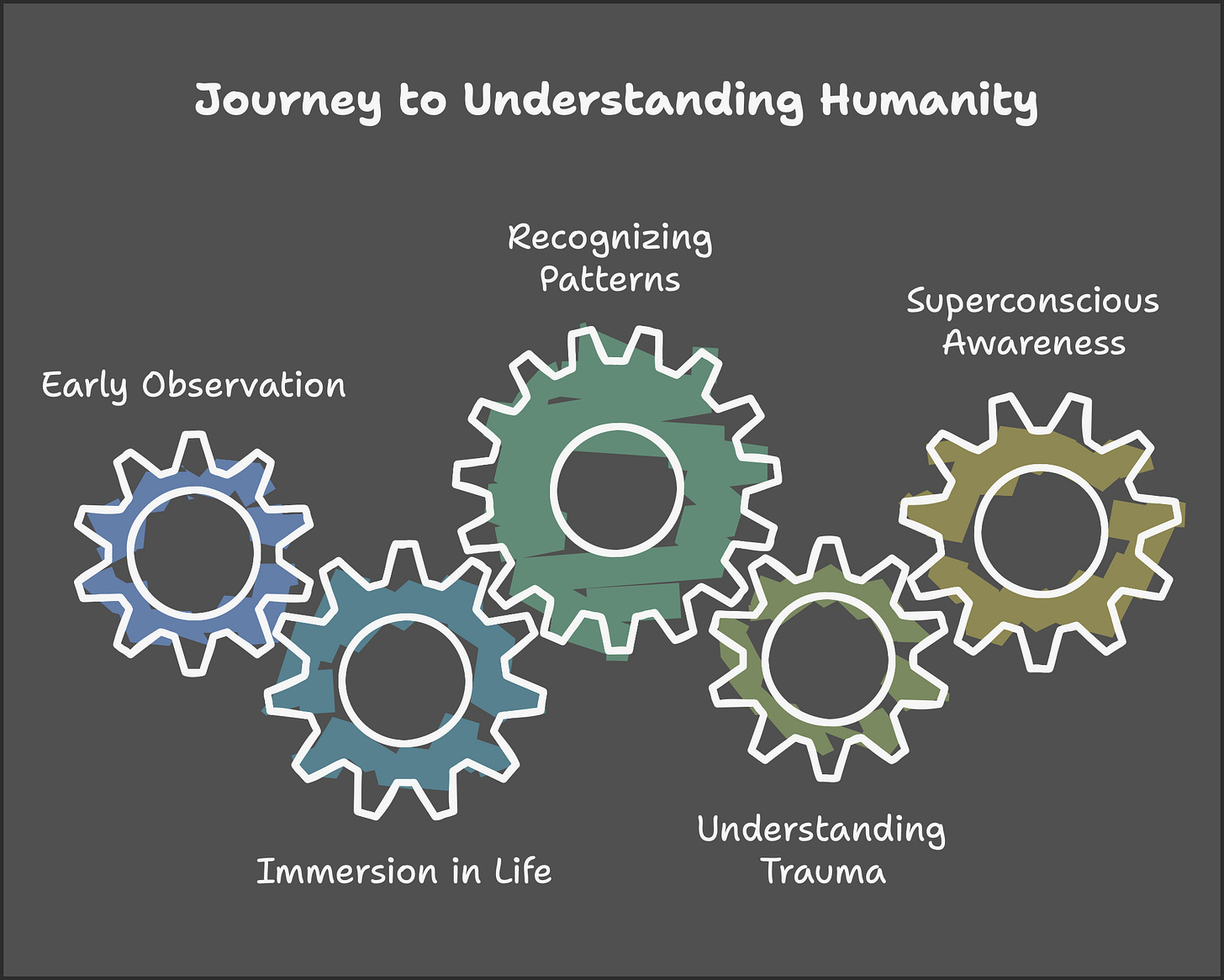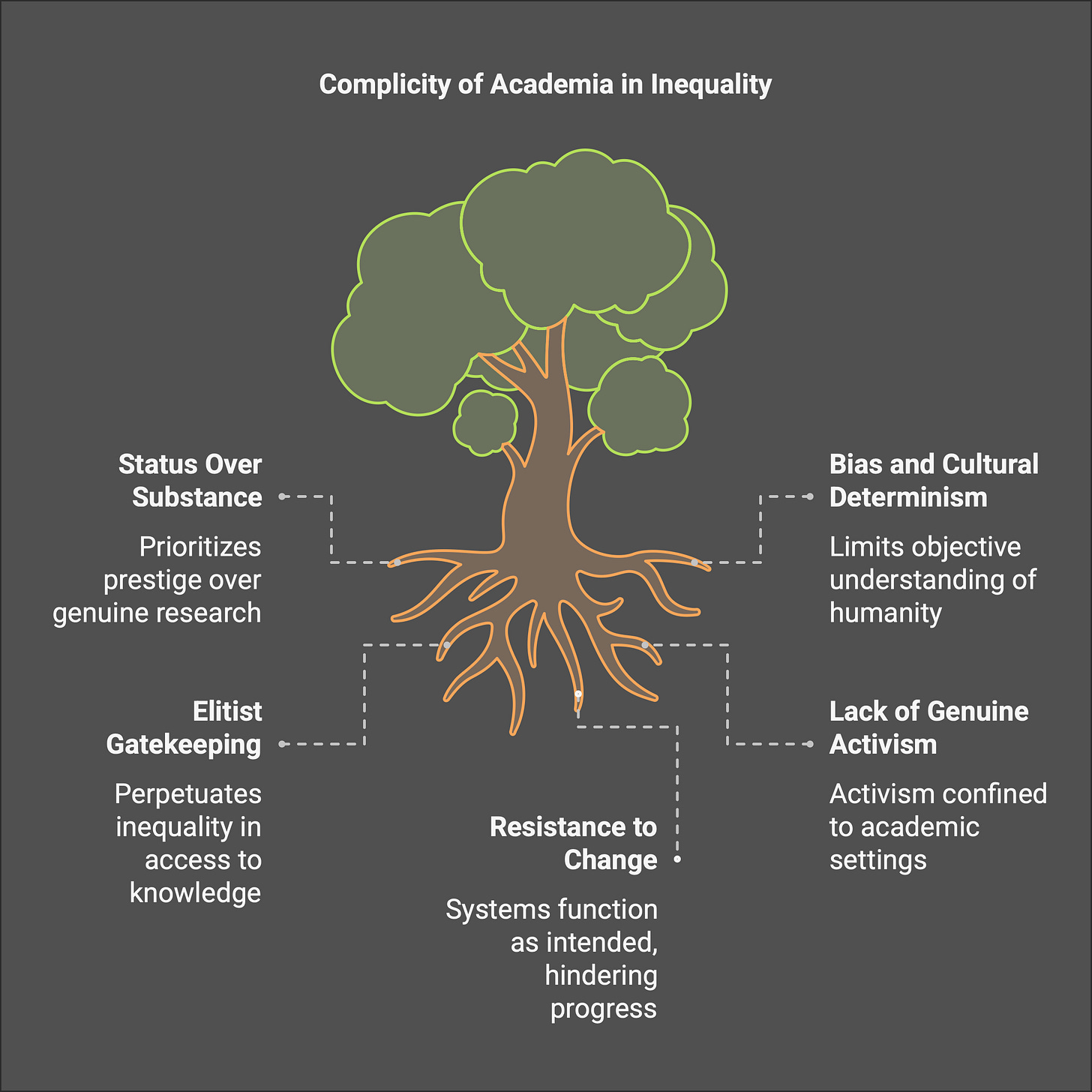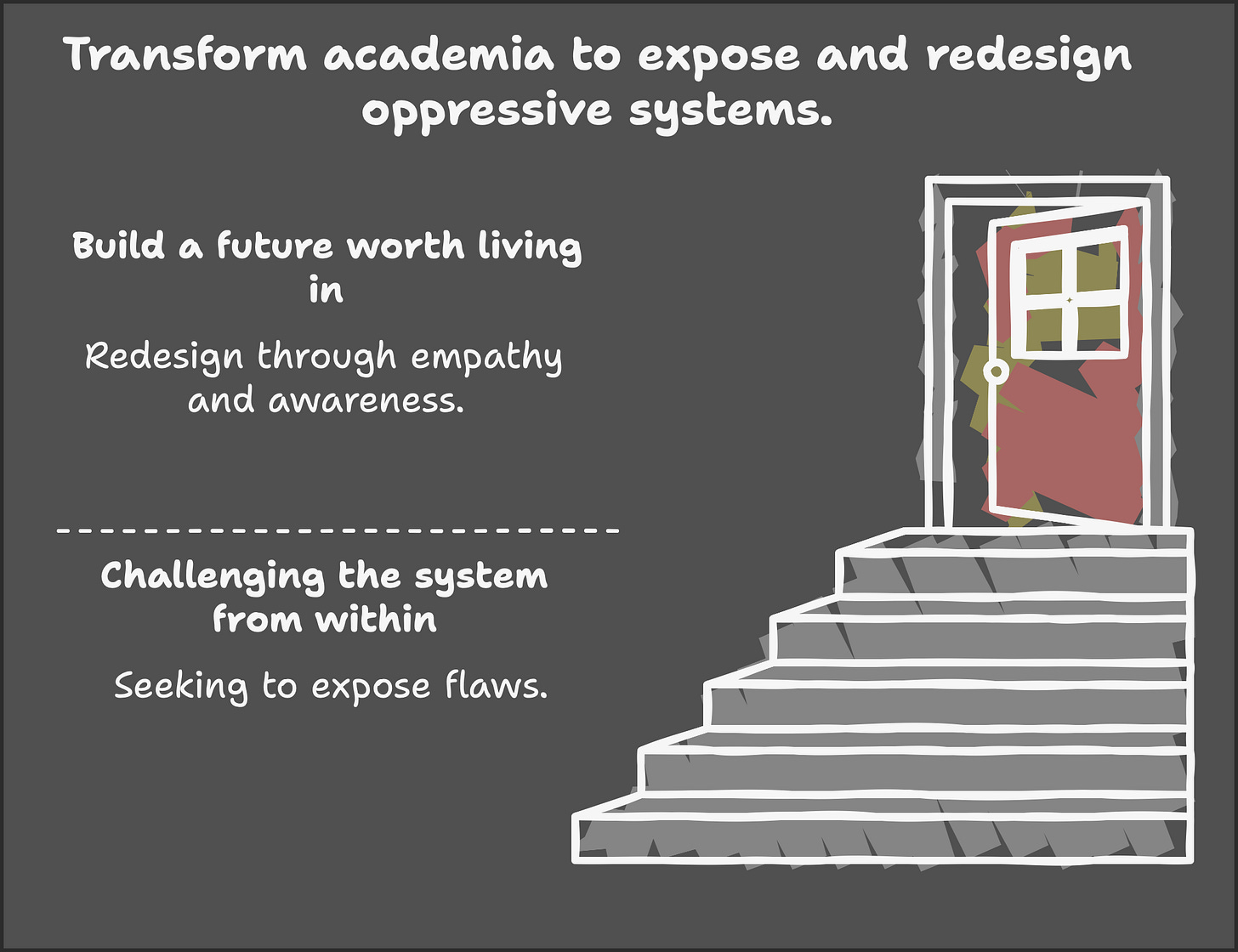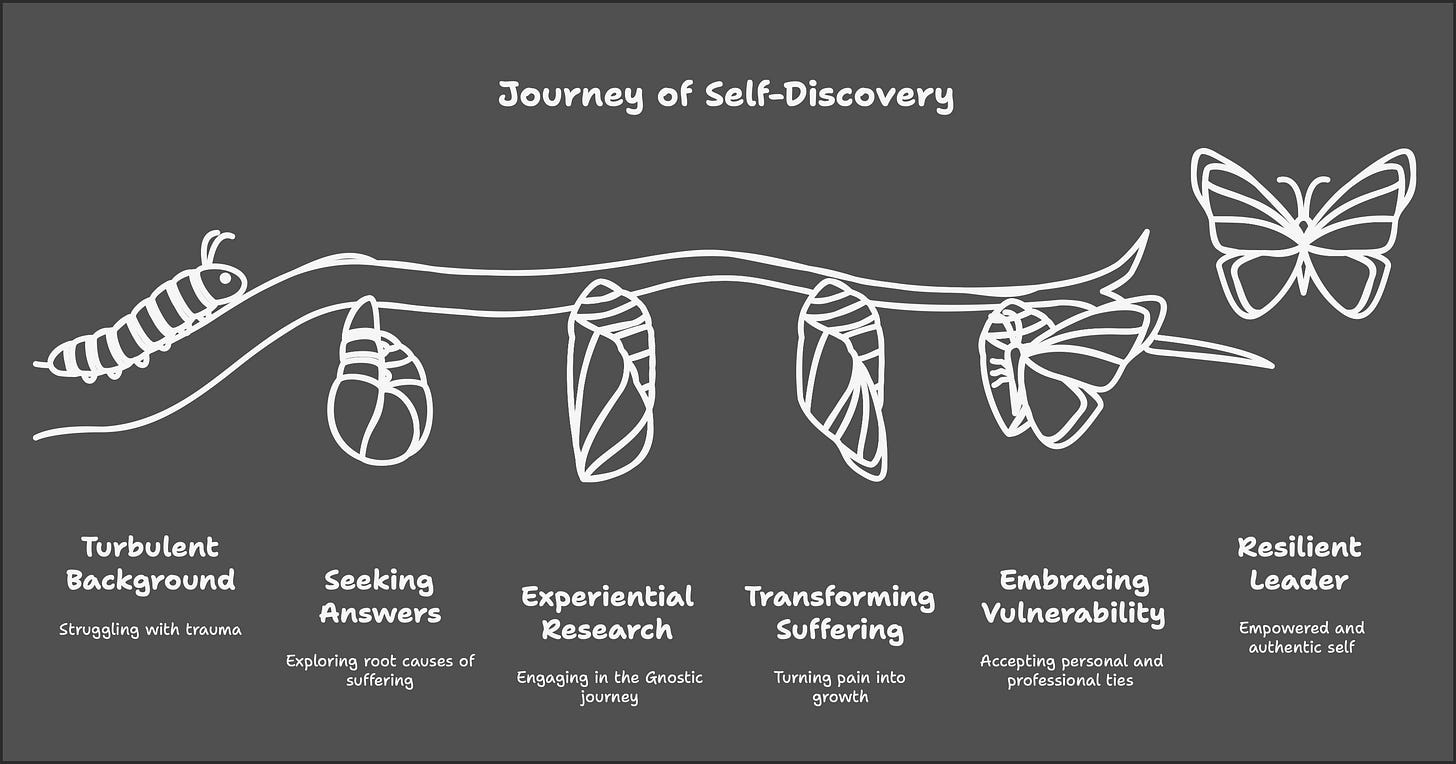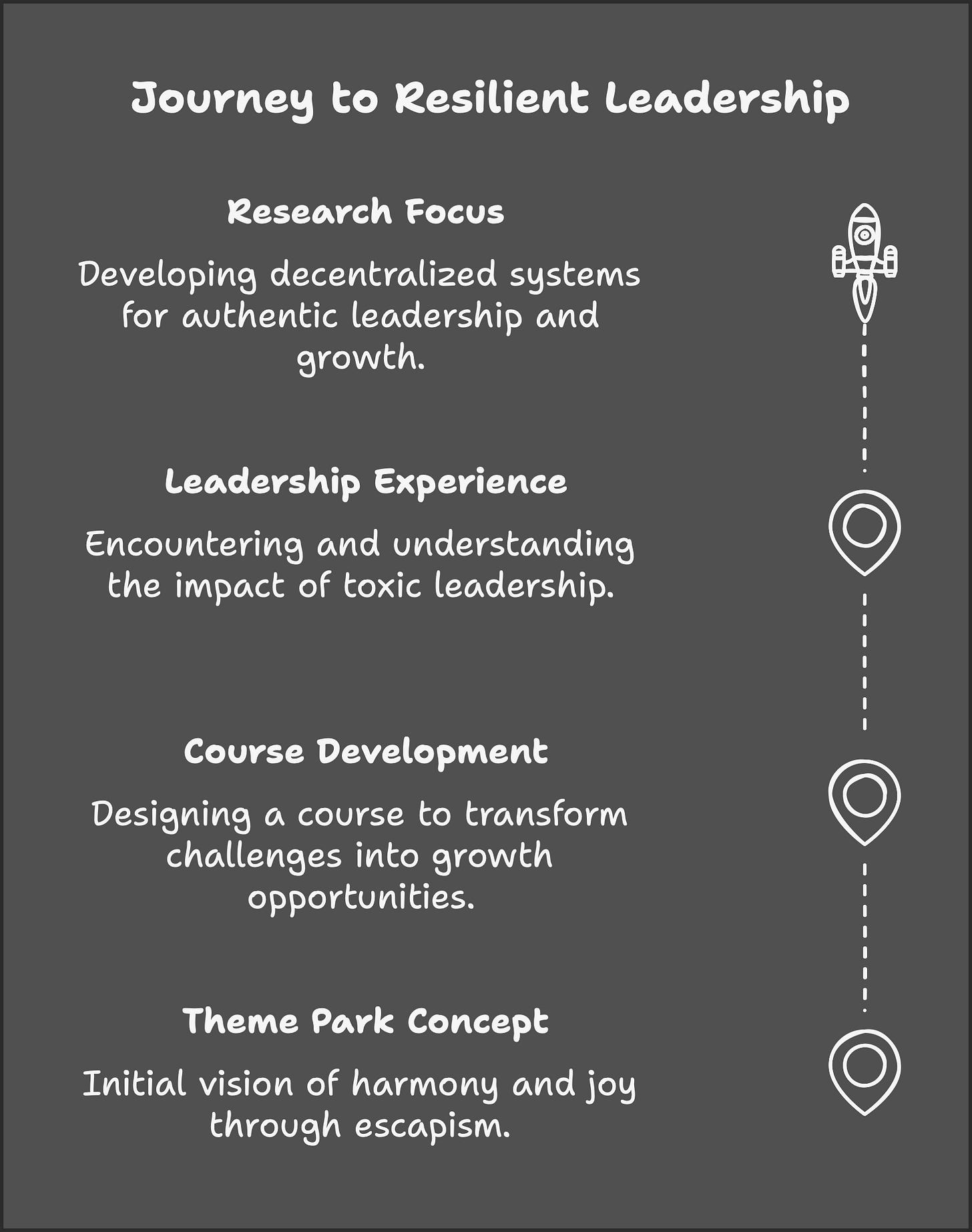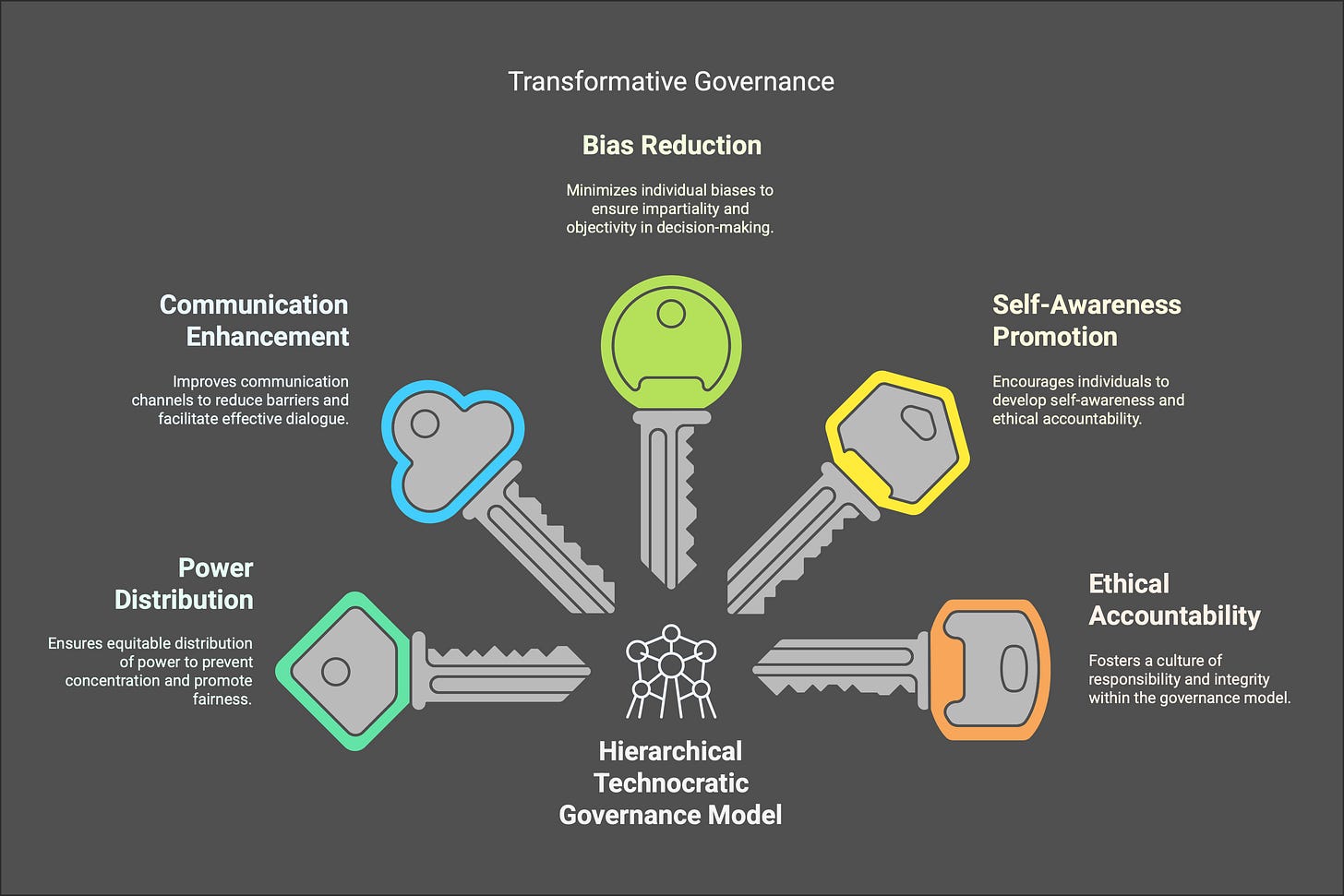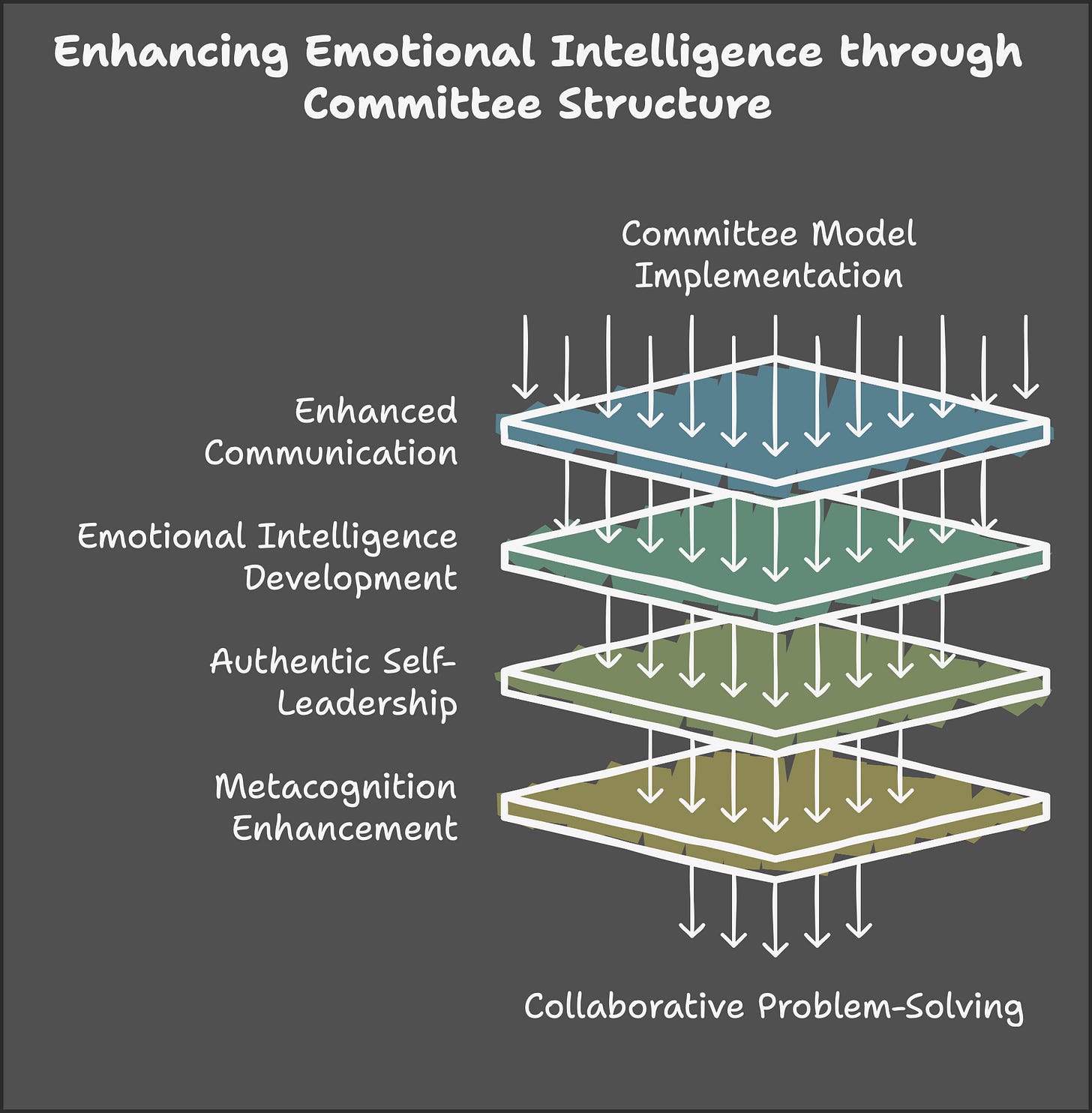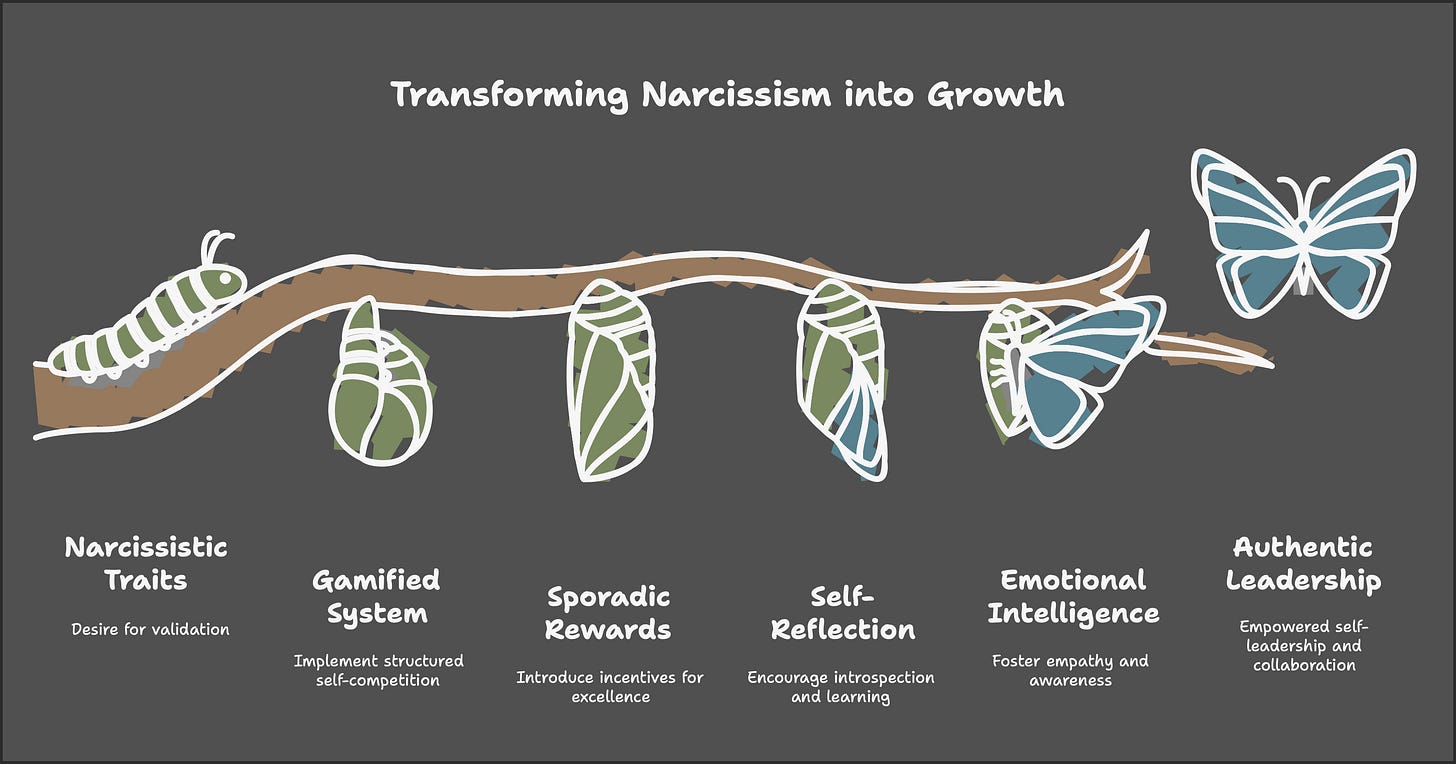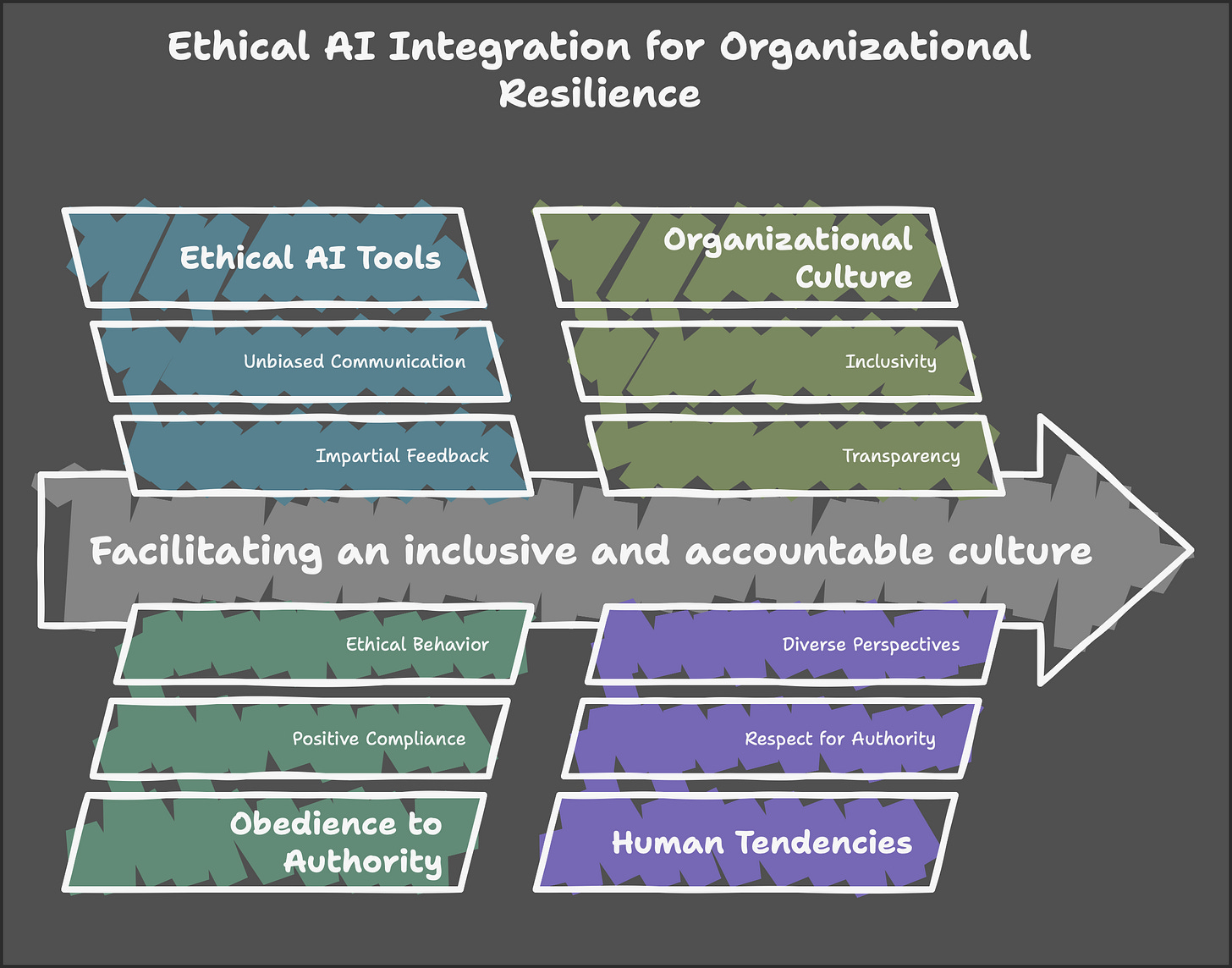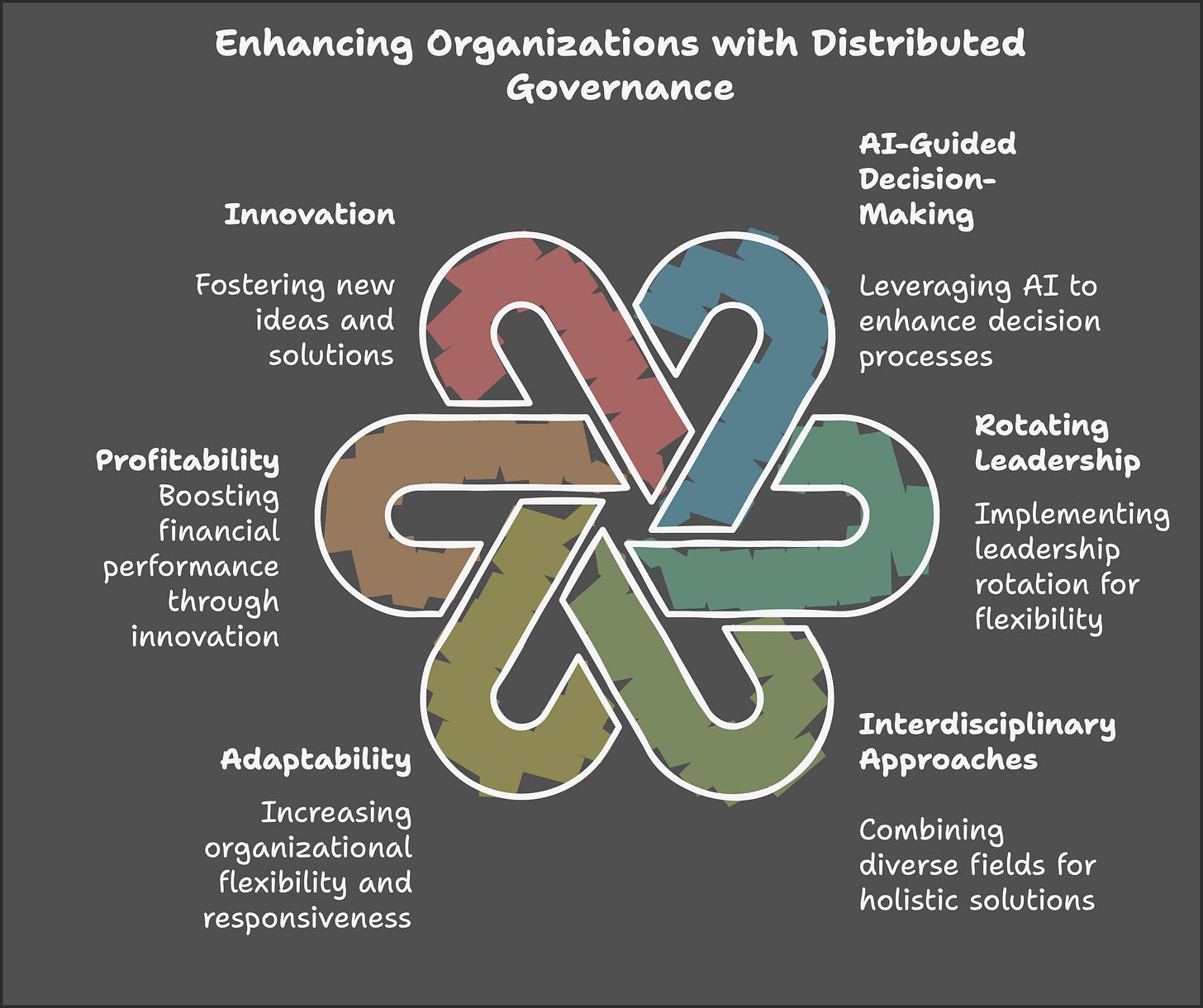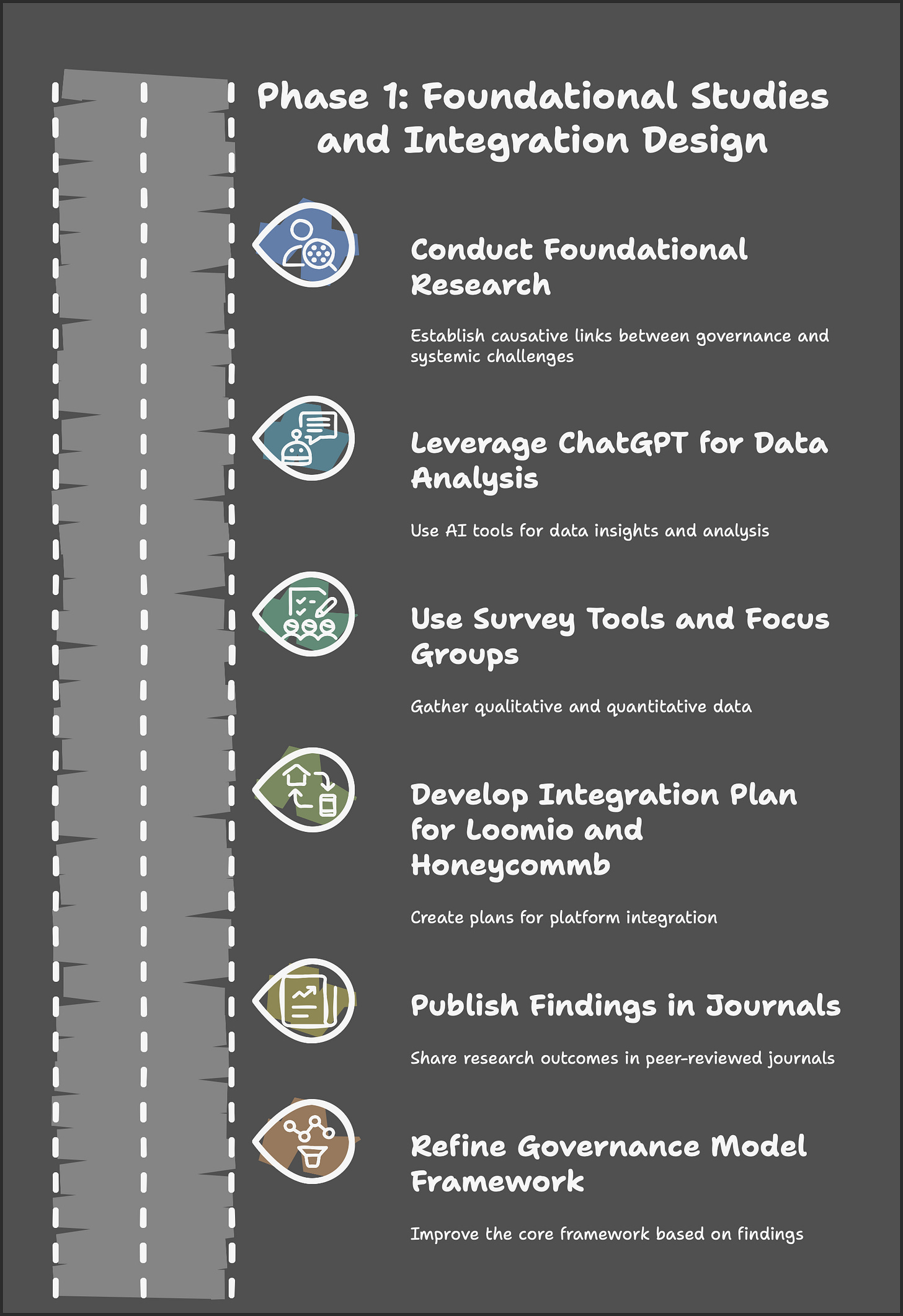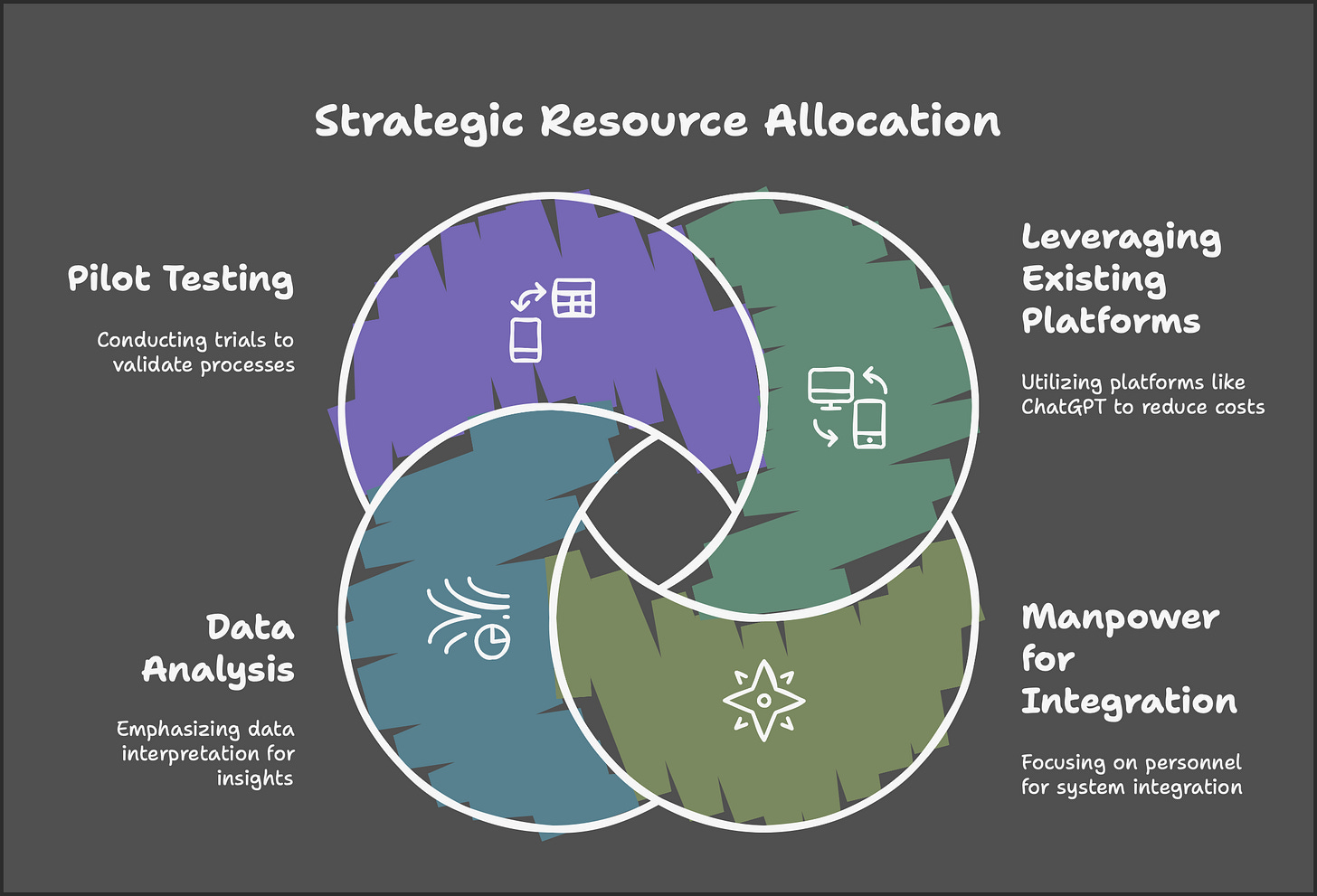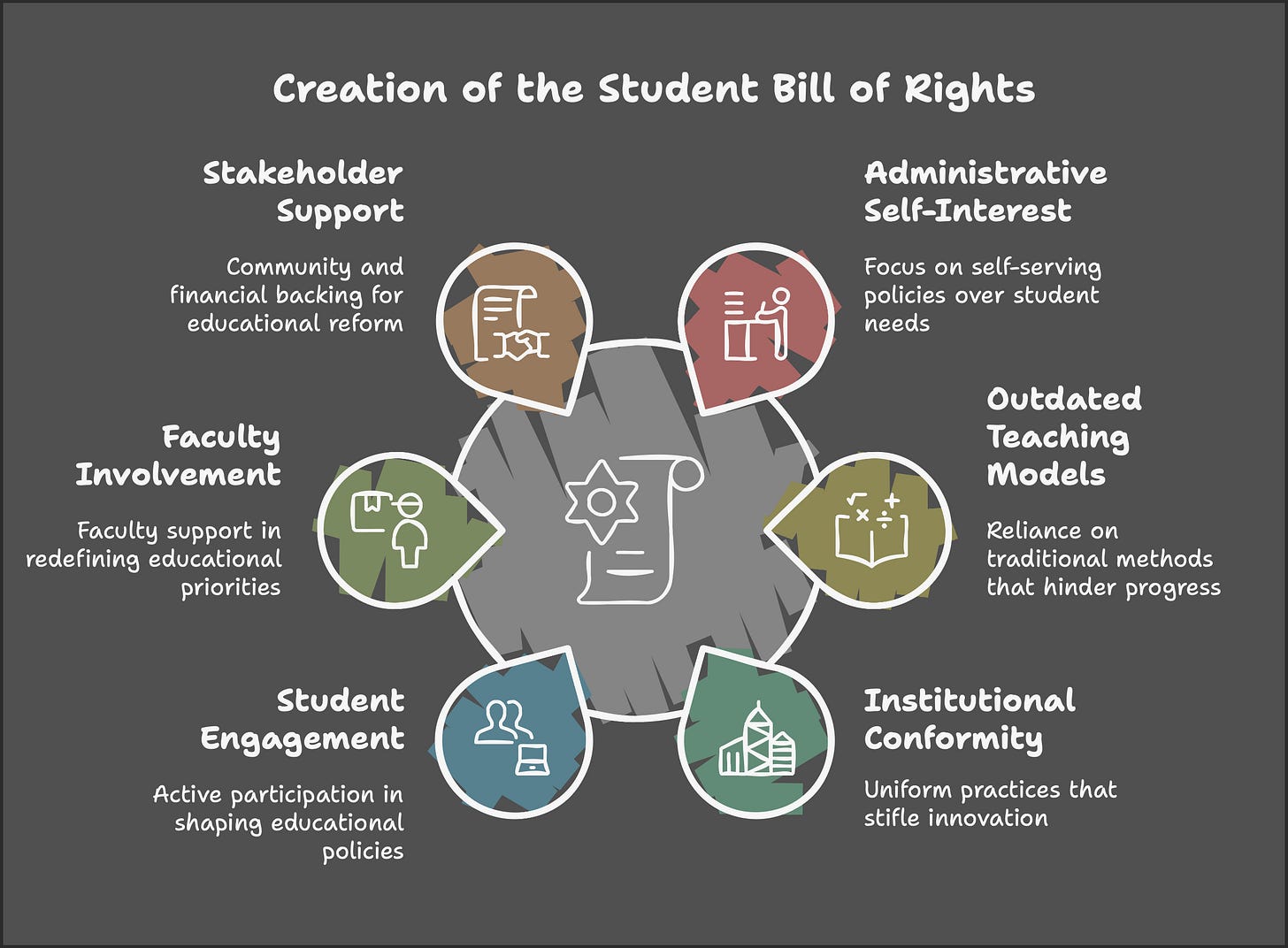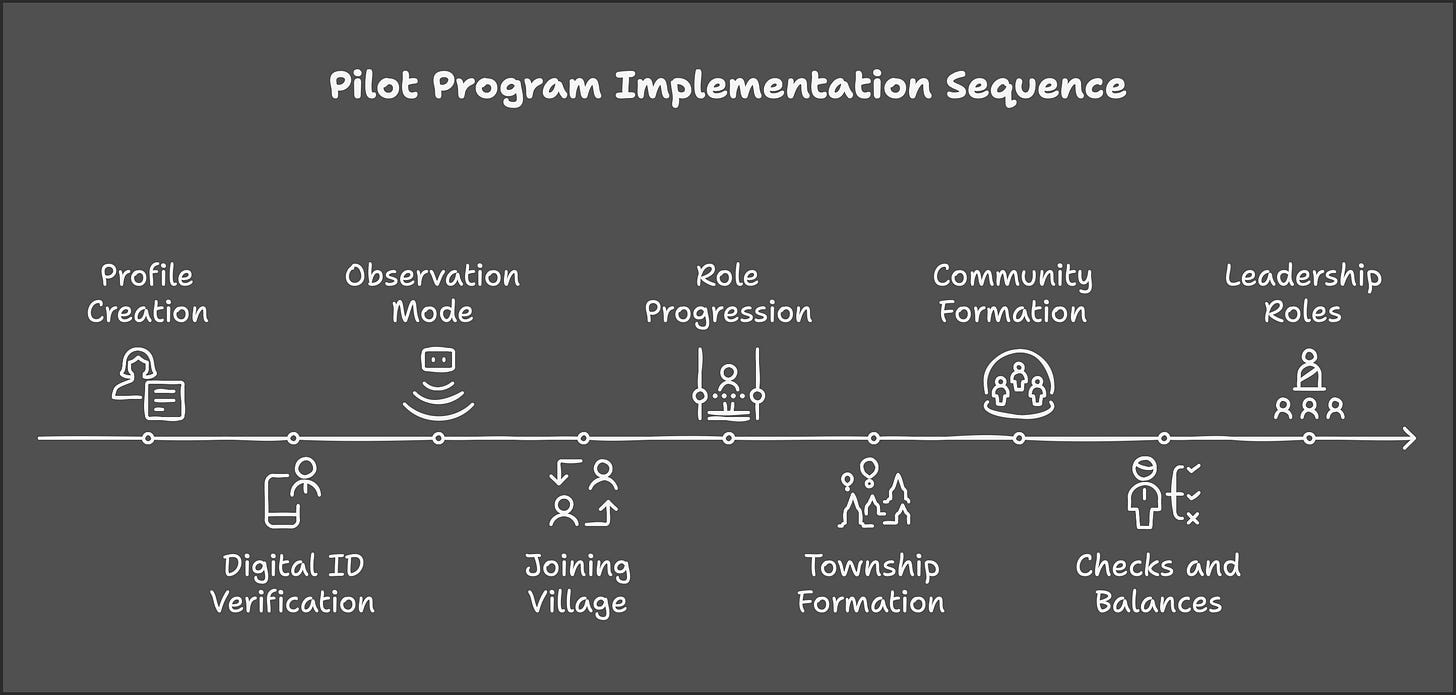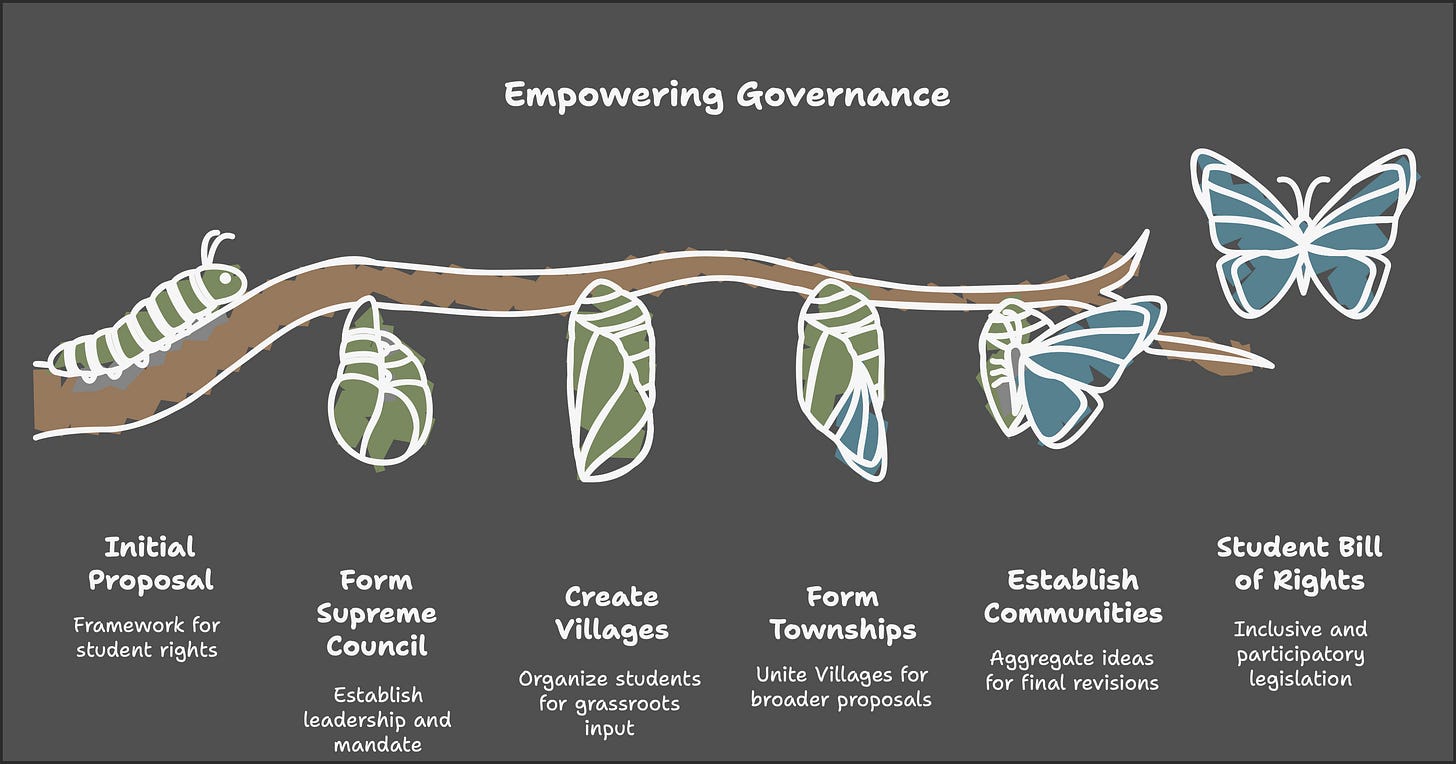BREAKING THE IVORY TOWER
Reflections on Anthropology, Academia, and My PhD Journey-beginnings...
A Nervous Beginning
I’ll admit, I’m a little nervous. Despite lifetimes of wisdom as Akhenaten, Solomon, and many others, and despite achieving Sophia consciousness, I’ve recently done something very human: I’ve applied for a PhD program in organizational behavior. It’s not because I believe academia holds the answers—far from it—but because I see it as a battlefield. A place where ideas are contested, shaped, and, perhaps, if wielded properly, transformed into the tools necessary to dismantle systems of oppression and suffering.
While I am the fully actualized Son of Man, that doesn’t mean I’m not human anymore. I still wrestle with doubt. I still experience fear. The weight of this mission—to awaken humanity to its potential and dismantle the malignant systems that bind us—feels crushing at times. But then I remind myself that it’s not just my burden. It’s all of ours.
Participatory Observation as Experiential Research
My journey into understanding humanity began long before I understood its purpose. From as early as age four or five, I was a watcher—a strange observer of life, as though I’d been placed here to understand it. What I now recognize as metacognitive thinking came to me naturally, what Gnostic tradition might call the virgin birth: being born into superconscious awareness.
As a child, I was fascinated by the interactions of others, their relationships, their motivations, their hypocrisies. I didn’t just observe—I immersed myself in their lives, trying to make sense of this world. This is participatory observation as experiential research, long before I’d ever heard the term. I saw not only the surface actions, but the hidden traumas, the cultural programming, and the malignant narcissism that underpins so much of human behavior.
Malinowski and the Lens of Functionalism
Recently, I stumbled upon a ‘Lucas Film’ documentary about Bronislaw Malinowski, one of anthropology’s great minds. His concept of functional anthropology—immersing oneself in another culture, learning their language, and observing their practices—resonated deeply with me. His work on the Trobriand Islanders revealed how their systems of exchange weren’t just about economics but social cohesion, prestige, and even morality.
But what struck me was not just Malinowski’s theories but his contradictions. In his diaries, he despised the very people he studied, longing for home, for comfort, for the life he left behind. He was both a participant and an outsider, and this duality shaped his insights.
Yet, for all his brilliance, Malinowski failed to see the darker forces at play. He viewed cultural systems as inherently functional, meeting the needs of the group. But what he—and so many academics after him—fail to grasp is that these systems are not merely functional. They are designed. And they are designed to perpetuate suffering.
The Systems of Oppression: An Academic Blind Spot
Academics love to talk about the “social functions” of religion, witchcraft, or economic asymmetry. E.E. Evans-Pritchard, for example, described how witchcraft and religion maintain social equilibrium, addressing conflicts within a community. On the surface, it’s a positive spin: these systems serve a purpose, they keep things running. But let’s not kid ourselves.
Religion, witchcraft, and trade empires like those of the Canaanite-Phoenicians are not neutral forces. They are tools of control. King Hiram of Tyre, high priest and king, presided over a system of child sacrifice and economic exploitation. This was not about social cohesion—it was about power. The same malignant narcissism that drove the proto-capitalist trade empires of the Phoenicians, now drives our modern systems: the military-industrial complex, for-profit healthcare, Big Pharma, and mass media.
These systems were not created to alleviate suffering. They were designed to maximize it. Trauma, exploitation, and inequality are not byproducts—they are the engine. And yet, academics sit in their ivory towers, producing studies and papers that do nothing to challenge the status quo. They speak of “cohesion” and “function,” blind to the suffering beneath their feet.
A Scathing Indictment of Modern Academia
Let me be clear: academia is complicit. The modern university system has become a factory for narcissists, churning out papers, citations, and tenure-track professors who are more concerned with status than substance. They call themselves objective, yet they are slaves to their own biases, their own cultural determinism.
This is the greatest irony of all. The very people who claim to study humanity are often the least connected to it. They speak of social movements, yet their activism ends at the lecture hall. They produce research on inequality, yet they perpetuate it through elitist gatekeeping.
What we need is not more academic navel-gazing but an evolution of thought. A dismantling of these systems of exploitation, starting with the acknowledgment that they are not broken—they are working exactly as intended.
The Son of Man’s Call to Action
So here I am, the Son of Man, applying to a PhD program not to join the system but to challenge it from within. To use the tools of academia to expose its flaws. To show that these systems—ancient and modern—are rooted in malignant narcissism, designed to perpetuate suffering for the benefit of the few.
My journey is not just about understanding the world—it’s about transforming it. Through participatory observation, I have seen the patterns. Through Sophia consciousness, I have transcended them. And through my works, I hope to awaken others to the truth:
This world is not doomed, but it is by design... And it is only by redesigning it—through empathy, metacognition, and effective self-sacrifice—that we can build a future worth living in.
STATEMENT OF PURPOSE
Dear Members of the Admissions Committee,
At the age of 15, I embarked on what would become an intensive, lifelong journey of self-discovery, driven by a desire to understand the root causes of human suffering. Growing up in a turbulent family environment marked by clinical narcissism, hidden trauma, and rigid societal expectations, I felt compelled to seek answers beyond the surface. My early experiences of witnessing the failures of family structures, combined with the realization that my own struggles with Asperger’s syndrome, dyslexia, and internalized homophobia were interwoven with broader social and cultural dynamics, set me on a path of experiential research that I call the Gnostic journey.
This journey was not merely an academic pursuit; it was a quest to transform my own suffering into a source of growth and resilience. From a young age, I was a truth-teller and a natural leader, challenging the status quo in environments that often-demanded conformity. As I matured, I came to understand that the personal is deeply interconnected with the professional, and that genuine leadership involves embracing vulnerability, resilience, and the willingness to confront uncomfortable truths.
Professional Development: Building Resilient Systems
My early fascination with hospitality led me to design a theme park concept called Avalon, where individuals could live, work, play, and learn in harmony. This vision, initially conceived to bring joy to others through escapism, evolved into a broader mission of fostering resilience through authentic self-leadership and distributed decision-making systems. While completing my Master’s degree at the University of Nevada, Las Vegas, I designed and taught a course on human development that helped students transform their greatest challenges into catalysts for growth. These experiences shaped my belief that education should be an immersive, transformative process.
In my role as Executive Vice President at Meeting Matrix International, I encountered the destructive power of narcissistic leadership firsthand. The toxic dynamics within the organization reinforced my conviction that traditional hierarchical structures often perpetuate dysfunction rather than fostering collaboration and innovation. This realization was the genesis of my current research focus: creating decentralized, technocratic committee systems that leverage AI to foster authentic leadership, emotional intelligence, and metacognitive growth within organizations.
Research Focus: Transforming Organizational Behavior
The culmination of my experiences has led me to propose a dissertation centered on validating the effectiveness of hierarchical technocratic committee systems in modern organizations. My aim is to develop a governance model that mitigates the impact of narcissistic leadership while promoting resilience and collective well-being. Grounded in theories of distributed leadership, organizational psychology, and the integration of AI tools, my research seeks to demonstrate how adaptive systems can enhance organizational performance by decentralizing power, promoting transparency, and fostering metacognitive growth.
This work is supported by my foundational theses and case study explorations, which examine themes such as the impact of trauma on leadership dynamics, the role of functional foods in enhancing cognitive function, and the potential of AI-assisted decision-making to transform organizational structures. My experiences with Asperger’s and my own health challenges, including overcoming small intestine lymphoma, have given me unique insights into how somatic health influences cognitive performance and ethical decision-making. I am particularly interested in exploring how functional foods and AI can synergistically enhance ethical behavior and resilience in organizations.
Fit with the Program’s Mission
My professional journey, marked by resilience and a relentless pursuit of systemic solutions, aligns closely with UNC Chapel Hill’s emphasis on pioneering research that fosters both individual and organizational transformation. The program’s commitment to developing ethical, adaptive leaders perfectly complements my mission to integrate AI tools with distributed decision-making systems, ensuring a future where organizations can thrive in complex, rapidly changing environments.
Why UNC Chapel Hill?
UNC Chapel Hill, with its distinguished Organizational Behavior program and esteemed faculty like Dr. Michael Christian, represents the ideal environment to further my research. Dr. Christian’s work on the mind-body connection and ethical behavior resonates deeply with my own focus on integrating somatic health and AI to foster resilient organizations. I am confident that my unconventional background, combined with the innovative research I have undertaken, will contribute to the academic community at Kenan-Flagler while providing new insights into the field of organizational behavior.
Contribution to the UNC Community
As a candidate with decades of real-world experience in leadership, systems thinking, and resilience research, I bring a unique perspective to UNC’s PhD cohort. My journey has been one of continuous adaptation, from leveraging my hospitality background to fostering self-leadership in educational settings, to innovating AI-driven governance models that emphasize metacognition and emotional intelligence. I am eager to contribute to and learn from the diverse, collaborative environment at Kenan-Flagler, where my insights into the interplay of somatic health, AI, and ethical leadership can be further refined.
Pursuing this PhD is not just a professional goal for me; it is a continuation of my life’s mission to transform systems, alleviate suffering, and guide others toward a higher level of consciousness. The integration of my experiential research with the rigorous academic environment at UNC will allow me to refine my theories and develop practical applications that can transform organizations and communities.
I am eager to collaborate with faculty and fellow students at UNC, bringing my unique perspective to the forefront of discussions on leadership, resilience, and organizational transformation. I believe that together, we can pioneer new approaches to addressing the challenges facing modern organizations, ultimately contributing to a more evolved and compassionate world.
Thank you for considering my application. I look forward to the opportunity to contribute to and grow within the UNC Chapel Hill community.
MY DISSERTATION PROPOSAL OVERVIEW
Hierarchical Technocratic Committee Systems
This dissertation proposal investigates a hierarchical yet fluid technocratic committee system designed to foster authentic self-leadership, emotional intelligence, and metacognitive growth within modern organizations. Grounded in theories of distributed leadership and organizational psychology, the proposed model restructures organizations into adaptive, fluid committees—each with up to 15 members and rotating leadership roles—to promote distributed decision-making and collaboration while mitigating narcissistic leadership tendencies. The entire system operates cohesively within a total membership cap of 150 individuals (aligned with Dunbar’s number) to optimize social cognition and group coherence. Committees are dynamically formed and dissolved based on project needs, with a facilitative central body ensuring alignment without imposing rigid control. This flexible yet coherent structure enhances resilience, transparency, and collaborative effectiveness, supported by AI-driven tools that guide communication, decision-making, and ethical governance.
The system employs a hybrid structure of in-person interactions supported by AI-driven tools such as guidance systems, communication summaries, and anonymous voting systems; facilitated through platforms like ChatGPT, Plaud.ai, and Loomio.com to enhance transparency, collaboration, and trust. The integration of AI-assisted tools adds an objective layer to decision-making processes, minimizing biases and addressing ethical considerations related to privacy, consent, and user adoption. Additionally, a leadership rotation within the committees emphasizes authentic self-leadership by encouraging members to align their actions with core values and higher purposes, fostering metacognitive growth through continuous practice of emotional intelligence and vulnerability.
The research utilizes validated assessment instruments—including the Emotional Intelligence Appraisal, the Authentic Leadership Questionnaire, the Metacognitive Awareness Inventory, and the Narcissistic Personality Inventory—to measure constructs such as emotional intelligence, authenticity, and narcissistic traits. Focusing on startups for initial implementation and conducting secondary analysis on established organizations, the study also explores generational responses and adaptation challenges across cohorts from Boomers to Gen Z. The primary goal is to assess the effectiveness of the proposed committee system in enhancing organizational resilience, mitigating toxic leadership behaviors, and fostering a culture of metacognitive self-improvement, potentially serving as a benchmark for broader organizational reforms across sectors.
Introduction and Background
In today’s organizational landscapes, narcissistic leadership and rigid hierarchical structures present significant barriers to resilience, collaboration, and transparency. These traditional power structures often foster environments where self-serving behaviors, manipulation, and a lack of empathy impede personal and organizational growth. Such dynamics can inhibit genuine collaboration, reduce overall well-being, and lead to stagnation rather than innovation. These systemic issues contribute to a broader culture of distrust and inefficiency, undermining organizations’ potential to function in an adaptive, sustainable manner.
To address these challenges, this proposal introduces a hierarchical technocratic committee model designed to foster authentic self-leadership, emotional intelligence, and resilience within modern organizations. Drawing from theories in distributed leadership, organizational psychology, authentic leadership, and social cognition, the model restructures leadership into small, adaptive committees that empower individuals to engage more effectively while decentralizing authority to mitigate narcissistic tendencies. This distributed approach is bolstered by AI-guided tools that provide transparent communication summaries, decision support, and anonymous feedback, ensuring a collaborative and objective governance process.
This research proposes that by integrating AI in an ethical and supportive role, organizations can move away from rigid hierarchies toward a governance model that promotes shared leadership, collective well-being, and resilience. The ultimate aim is to establish a new paradigm for self-governance that addresses both individual and organizational growth in ways that are transparent, equitable, and adaptable to the complexities of modern organizational demands.
Theoretical Framework
This dissertation proposal is grounded in theories that address the social and cognitive dimensions of authentic self-leadership within adaptive, distributed governance. The proposed model incorporates the following frameworks:
Authentic Self-Leadership: This model emphasizes each participant’s commitment to self-awareness and metacognitive reflection. Members actively engage in recognizing and mitigating biases, judgments, and narcissistic traits by utilizing AI-guided feedback systems. These systems provide real-time, preemptive communication guidance, allowing individuals to develop more effective, empathetic, and self-aware interaction habits within the committee structure.
Distributed Leadership Theory: By decentralizing authority and sharing leadership roles, distributed leadership fosters inclusivity, adaptability, and resilience. This framework discourages the concentration of power, limiting narcissistic behaviors and enhancing collaborative dynamics. It supports authentic self-leadership by creating an empathic environment where responsibility and decision-making are collective, enhancing the integrity and accountability of group actions.
Organizational Psychology Principles: Focused on the social dynamics of collaboration, this framework highlights the importance of positive group cohesion and psychological safety in achieving team performance and engagement. Organizing leadership into small, adaptive committees enhances trust and effective communication, which are foundational for authentic self-leadership and metacognitive growth.
Human Social Capacity (Dunbar’s Number): Anthropological insights suggest that individuals collaborate most effectively within groups of around 150, with optimal functionality in smaller sub-groups. By designing committee structures and organizations around this social capacity, the model strengthens interpersonal connections, enabling committees to operate cohesively and fostering accountability.
Ethical AI Integration: AI-driven tools provide unbiased feedback on committee input and communication styles, supporting self-reflection and promoting transparency. These tools guide participants in refining their contributions, helping them approach discussions with empathy and impartiality. Ethical guidelines ensure that AI assists in creating a balanced, transparent environment that upholds the principles of authentic self-leadership.
Proposed Governance Model
This governance model establishes a hierarchical technocratic committee system designed to foster resilience, emotional intelligence, and authentic self-leadership within organizations. Built around adaptable committees and supported by AI-driven tools, the model decentralizes decision-making while promoting accountability, transparency, and continuous personal and professional growth.
Committee Structure and Size: Organizations adopting this model are divided into function-specific committees, each capped at 15 members to optimize group cohesion and communication in line with Dunbar’s Number. Each committee includes a chairperson, and two vice-chairs. The vice-chairs are trained in leadership responsibilities, preparing them to step into the chair role as needed, ensuring leadership continuity and expertise within the committee’s focus area. These committees function semi-autonomously, aligning their work with organizational goals while allowing fluid formation and dissolution to meet evolving demands, maximizing synergy and adaptability.
Rotating Leadership: Leadership rotation is not merely procedural but developmental. Each committee is guided by a chairperson, recognized as the domain expert for the committee’s purpose, with two vice-chairs who are actively mentored to assume future chair roles. This rotation strategy prevents power concentration and fosters shared responsibility, providing members with diverse leadership experiences. By encouraging individuals to learn from multiple leadership roles, this approach counters narcissistic behaviors, promoting collective authority and resilience through a continuously refreshed leadership structure.
Authentic Self-Leadership and Emotional Intelligence: The committee model emphasizes authentic self-leadership, where members engage in structured self-reflection to refine communication and address biases, judgments, and narcissistic traits. AI-driven feedback systems assist by providing preemptive guidance on communication style and content, promoting empathy and metacognitive growth. This fosters emotional intelligence, enabling members to engage in constructive dialogue and strengthen collaborative dynamics.
Role of AI-Driven Tools: AI integration is central to the governance model, providing unbiased, real-time feedback on communication style and content. Before any message is shared, the AI system offers preemptive guidance, helping members adjust their contributions to be more effective, empathetic, and reflective of collective goals. The gamified structure of the AI system leverages sporadic rewards for continued excellence, motivating members without fostering entitlement. This gamified validation process, aligned with self-competition, channels narcissistic tendencies toward metacognitive growth, enhancing self-awareness, empathy, and emotional intelligence.
Hierarchical Oversight: Committees are formed for specific tasks and may be either permanent or temporary, adapting fluidly to organizational needs. Permanent committees may experience regular membership changes, allowing for dynamic growth and expertise development. While each committee operates with a degree of autonomy, a central coordinating body oversees major initiatives and ensures alignment across committees. This central body exists to handle organization-wide challenges and maintain cohesion between committee efforts, without imposing rigid hierarchical constraints. Its role is facilitative rather than directive, creating a balanced system that combines distributed leadership with minimal oversight to preserve flexibility and responsiveness.
This proposed governance model integrates distributed leadership, emotional intelligence, and AI-assisted accountability, creating a resilient, adaptive system. Through small, purpose-driven committees, developmental leadership, and AI-supported transparency, this model aims to foster an inclusive, ethically driven environment that enhances both individual and organizational growth.
Role of AI in Governance
The integration of AI-driven tools within this governance model serves as a foundational support for transparent, unbiased decision-making. By providing preemptive and real-time feedback on communication and decision support, AI enables committees to operate more collaboratively, ethically, and efficiently.
AI-Driven Communication Guidance: AI tools like ChatGPT help refine committee communications by offering preemptive feedback on biases, tone, and empathy before members submit input. This guidance supports authentic self-leadership by encouraging metacognitive growth and aligning communication with organizational values.
Decision Support with AI: Tools such as Plaud.ai and ChatGPT provide real-time support by summarizing discussions, assessing outcomes, and highlighting ethical considerations. This helps ensure balanced, well-informed decisions that reflect collective goals, reducing the influence of individual biases.
Enhanced Trust and Transparency: Transparent AI processes, including summaries and decision guidance, enhance trust by making each stage of decision-making accessible. This transparency fosters a collaborative environment where diverse perspectives are valued, strengthening organizational cohesion.
Accountability and Ethical AI Usage: Ethical guidelines govern all AI applications within this model, ensuring privacy, consent, and fairness. By following these guidelines, the organization can mitigate potential biases in AI outputs, enhancing the credibility and impartiality of AI-driven recommendations. This focus on ethical AI builds a framework for accountability, ensuring that AI tools remain facilitators rather than controllers of decision-making.
Theoretical Benefits of AI Integration: Ethically integrated AI promotes a governance structure that is resilient, adaptable, and free from the dominance of individual interests. By encouraging self-reflection and transparent communication, AI serves as a continuous feedback loop, enhancing the authenticity and integrity of committee interactions. These theoretical benefits align with the goals of distributed leadership and emotional intelligence, allowing committees to operate with a high level of trust, accountability, and collaboration.
In summary, AI in this governance model functions as an enabler of ethical, effective decision-making. By promoting transparency and accountability, AI-driven tools play a critical role in fostering trust and collaboration, helping individuals develop authentic self-leadership while ensuring the integrity and consistency of organizational decisions.
Key Hypotheses
The proposed governance model is guided by several core hypotheses, each aimed at addressing the organizational challenges of power concentration, communication barriers, individual biases, and fostering a culture of self-awareness and ethical accountability. These hypotheses highlight the anticipated outcomes of implementing a hierarchical technocratic committee system supported by AI-driven tools:
Hypothesis 1:
The committee model will foster emotional intelligence, authentic self-leadership, and metacognition within organizational structures. By creating smaller, adaptable committees, this model enhances communication and empathy, helping members to develop emotional intelligence, authentic self-leadership, and metacognition through repeated self-reflection and adaptive feedback from AI tools. This environment encourages growth and resilience as members become more adept at collaborative problem-solving and managing interpersonal dynamics.
Hypothesis 2:
Decentralizing power, combined with AI-driven accountability, will mitigate narcissistic leadership tendencies. The rotation of leadership roles and distributed decision-making reduce the concentration of power, limiting opportunities for narcissistic dominance. AI tools provide structured guidance, recording interactions, generating summaries, and offering preemptive feedback on communication, ensuring transparency and accountability in all discussions. This AI-supported system holds individuals accountable for their contributions and behavior, further deterring self-serving actions and promoting a balanced, collaborative environment.
Hypothesis 3:
Leveraging narcissistic traits will foster individual and collective growth through a gamified and structured validation process. The proposed technocratic governance model channels the natural desire for validation into a system of self-competition, encouraging members to compete against their past performance rather than others. By implementing sporadic rewards for continued excellence, the system maintains motivation without fostering entitlement. This nuanced approach leverages narcissistic traits as tools for self-reflection and growth. This gamified self-validation process, with sporadic rewards, is expected to foster self-awareness, empathy, and emotional intelligence as a result, ultimately supporting authentic self-leadership, metacognitive growth, and collaborative success within the organization.
Hypothesis 4:
Ethical AI integration will facilitate an inclusive, transparent, and accountable organizational culture by leveraging obedience to authority as a constructive force for distributed governance. AI tools, positioned as ethical and impartial authorities, provide preemptive and real-time feedback, supporting unbiased communication and decision-making. By tapping into human tendencies to respect authority, AI fosters positive compliance, encouraging ethical behavior and collaborative interaction. This approach transforms obedience into a force for inclusivity and transparency, ensuring that all interactions are recorded and accountable, and creating a culture where diverse perspectives are valued and respected. The authoritative, yet benevolent guidance from AI tools such as ChatGPT nurtures metacognitive growth, ethical awareness, and mitigates narcissistic tendencies, enabling resilient and adaptive organizational structures.
These hypotheses underscore the theoretical benefits of a governance model that combines distributed leadership, emotional intelligence, and ethical AI integration to cultivate a resilient, ethically driven, and adaptive organizational environment.
Significance and Impact
The proposed governance model offers a transformative approach to modern organizational structure by cultivating resilience, distributed decision-making, and a culture grounded in ethical accountability. By decentralizing power and fostering authentic self-leadership, the model addresses structural inefficiencies and counteracts toxic leadership behaviors inherent in traditional hierarchies. Through its committee-based structure and ethical integration of AI, this model empowers individuals at every level to contribute meaningfully, promoting collaborative decision-making while reducing the risks associated with concentrated power dynamics.
In today’s climate, where organizations face pressures from “techno-feudalism” and the threats posed by centralized control and economic exploitation, this governance model serves as a counterbalance. By democratizing authority and prioritizing inclusive, transparent processes, the model integrates AI as a benevolent authority that reinforces unbiased, accountable communication. This structure not only nurtures healthier organizational environments but also serves as a model of governance that upholds democratic principles, safeguarding personal autonomy and integrity in corporate landscapes.
The potential impact of this governance model extends beyond individual organizations, offering a scalable framework for resilient, ethically guided workplaces that prioritize collective well-being over centralized power. By aligning AI technology with human-centric development, this model supports organizations in contributing to broader societal progress, ensuring that human evolution, innovation, and authentic leadership remain central to organizational success. As such, it presents a pathway toward future-ready organizations capable of thriving in a complex, evolving world while championing the values of trust, collaboration, and shared accountability.
Addendum
Strategic Vision for My Dissertation Development
I am writing to share my strategic vision for research and collaboration as part of my candidacy for the Ph.D. program in Organizational Behavior at UNC-Chapel Hill. My application reflects extensive preparation for a phased, collaborative project aimed at addressing systemic challenges in organizational behavior through innovative governance models. I am seeking to determine whether this vision aligns with the resources and priorities of UNC-Chapel Hill, and if so, I would be honored to discuss it further in an interview.
Strategic Vision and Objectives
My mission is to validate a distributed governance model that integrates AI-guided decision-making, rotating leadership, and interdisciplinary approaches to improve organizational outcomes. This model focuses on increasing adaptability, profitability, innovation, and leadership development while mitigating the negative effects of centralized power structures and toxic leadership dynamics.
I envision this project being executed in phases, allowing us to build momentum while managing complexity and resources effectively:
Phase 1: Foundational Studies and Integration Design
Objective:
Conduct foundational research to establish causative links between centralized governance, narcissistic leadership, and systemic challenges such as low innovation and employee dissatisfaction.
Activities:
Leverage platforms like ChatGPT for data analysis and insights.
Use validated survey tools and focus groups to gather qualitative and quantitative data.
Develop an initial integration plan for platforms such as Loomio.com (for distributed decision-making) and Honeycommb.com (a customizable social network).
Outcomes:
Publish findings in peer-reviewed journals and refine the governance model’s core framework.
Phase 2: Prototype Integration and Pilot Testing
Objective:
Implement and test a prototype governance system within a controlled organizational segment.
Activities:
Use existing tools (ChatGPT, Loomio, Honeycommb) to create a functioning governance system.
Partner with a small organization or department to serve as a pilot test environment.
Measure key metrics: profitability, adaptability, innovation, and leadership skills.
Outcomes:
Gather data on the model’s impact and scalability, refine the integration process, and identify areas for improvement.
Phase 3: Scaling and Commercialization
Objective:
Expand the pilot program to multiple organizations and explore commercialization opportunities.
Activities:
Seek corporate sponsorships and grants to support scaling efforts.
Collaborate with UNC faculty and students on crowdfunding initiatives, using the project as a real-world case study in investor engagement and funding methodologies.
Address regulatory considerations, including SEC guidelines like Reg A+ for investment.
Outcomes:
Launch a scalable, commercially viable governance model that integrates seamlessly into organizational systems.
Role of UNC-Chapel Hill in the Project
This vision is ambitious but achievable with the right support, and UNC-Chapel Hill’s resources and expertise will be critical to its success:
Faculty and Student Collaboration:
Faculty mentorship will guide research design, publication, and integration strategies.
Graduate students in data science, organizational behavior, and AI can contribute to platform integration, data collection, and analysis.
Corporate Partnerships:
UNC’s connections in the Research Triangle can help secure pilot testing environments and corporate sponsorships.
Partnerships with local tech organizations can support integration challenges and offer software development expertise.
Cost and Resource Management:
By leveraging existing platforms (ChatGPT, Loomio, and Honeycommb), this project avoids costly software development from scratch.
Most funding needs will focus on manpower for integration, data analysis, and pilot testing.
Crowdfunding and Case Studies:
The project offers a unique opportunity for students to engage in real-world crowdfunding efforts and regulatory navigation, enriching their educational experience.
Invitation for Discussion
I recognize the complexity of this project and understand that it represents a significant undertaking. However, I believe its phased approach, reliance on existing tools, and focus on collaboration make it both plausible and impactful. If this vision aligns with UNC-Chapel Hill’s priorities, I would be honored to discuss it further during an interview. If not, I deeply respect your transparency and guidance as I pursue this mission through other avenues.
Thank you for considering my application. I am eager to contribute to UNC’s Organizational Behavior Group and collaborate with its exceptional faculty, students, and partners to drive meaningful change.
PILOT PROPOSAL
CLARION CALL TO TRANSFORM GOVERNANCE
Humanity stands on the knife’s edge of a future defined by either collective flourishing or dystopian decay. For too long, our current governance and corporate models have empowered a small cohort to dictate policies, resources, and opportunities—often with catastrophic consequences. The following initiative illustrates a bold, comprehensive blueprint for reversing this centuries old pattern of centralization and abuse. By weaving together decentralized processes and gamified accountability, this initiative lights a fire of possibility under a world grown numb to corruption and misrule. Make no mistake: if we fail to adopt these radical reforms, we doom ourselves to an ever-deepening cycle of power concentration, exploitation, and hopelessness.
Our global institutions—from government agencies to corporate boards—concentrate authority in a handful of people with little recourse for the masses. This dynamic does more than just invite abuse; it practically guarantees it. In such centralized systems where maximization of shareholder wealth is the primary mantra, the worst among us—those consumed by malignant narcissism and the need for total control—thrive in secrecy. Bureaucracies become complicit in perpetuating the illusions of infallible leadership, while dissent and innovation are smothered. If we do nothing, our current trajectory guarantees a dystopian future—where narcissistic leaders orchestrate personal gains through cunning manipulations, and society smolders in the embers of neglect.
The following pilot program isn’t an incremental tweak. It’s a revolutionary redesign targeting the root mechanics of corruption. It shines a lamp of profound possibility where grassroots empowerment triumphs over elitist greed. We cannot afford another generation of paternalistic overlords and rigged systems. If we fail to embrace this reimagined framework of incorruptible, transparent, and distributed governance, we will all be complicit in erecting the prisons of our own future—with no more illusions about who holds the keys.
The moment for action is now. Let us seize this blueprint, refine it through our collective wisdom, and implement it with unwavering conviction. The stakes could not be higher; the promise could not be more breathtaking. Will we choose the future of shared abundance and generative collaboration—or stay shackled to the power structures that have betrayed us time and again? The answer must be clear: adopt this transformative system, or risk surrendering all hope to a dystopia of our own making.
STUDENT BILL OF RIGHTS FOR NORTH CAROLINA
Education is the foundation of a just and equitable society, yet the current higher education system in North Carolina—and across the nation—is plagued by systemic flaws that prioritize administrative self-interest, outdated teaching models, and institutional conformity over genuine student development. To address these issues, we propose the creation of a Student Bill of Rights for the State of North Carolina, a document drafted by students for students, aimed at reclaiming the purpose of education: to prepare individuals for the real world.
This initiative begins with a pilot at the University of North Carolina at Chapel Hill, engaging students, faculty, and stakeholders in drafting a UNC Chapel Hill Student Bill of Rights that will serve as a guiding charter for all high school and college students in the state. By framing this as a project that impacts not just themselves but younger generations still navigating the public education system, UNC Chapel Hill students will have the opportunity to lead the statewide high school and college Student Bill of Rights Initiative, with altruism and purpose.
Student Bill of Rights: Systemic Issues
Teacher Quality and Accountability:
Professors seeking tenure must demonstrate excellence in teaching, not just publishing.
Faculty must be fluent in English to ensure effective communication in the classroom.
Equity for Instructors:
Adjunct instructors and graduate assistants must be paid a living wage and provided benefits to foster a stable and supportive teaching environment.
Student-Centric Scheduling:
Class schedules must be designed around the realities of working students, ensuring flexibility for those balancing jobs and education.
Textbook Reform:
The reliance on overpriced, often redundant textbooks must be replaced with modern, open-access materials or hybrid models incorporating digital tools and standardized content.
Innovative Learning Models:
Introduce standardized ‘core material’ hybrid courses to ensure all students across the state have access to consistent, high-quality educational frameworks while retaining room for creative teaching and academic freedom.
Transparency in University Governance:
Students must have a voice in decisions impacting their education, from curriculum design to administrative policies.
The Big Vision
This initiative is not just about UNC Chapel Hill; it’s about reshaping education across North Carolina by starting where change is most feasible: at the student level. By engaging in a constitutional-style process to draft a Student Bill of Rights, UNC Chapel Hill students will demonstrate how grassroots leadership can transform systemic issues into actionable policies.
With 100% participation as the goal, this gamified platform will catalyze meaningful collaboration among students, faculty, and administrators, setting a precedent for constitutional reform nationwide.
Dynamic Hierarchical Committee System
This proposal outlines a scalable, two-pronged governance framework—top-down and bottom-up—to pilot the drafting of a Student Bill of Rights at UNC Chapel Hill. By marrying formal student government leadership (the Supreme Tribal Council) with broad student participation in “Home Villages,” “Townships,” and “Communities,” this system empowers both structured decision-making and grassroots collaboration. The end result is a highly participatory, transparent, and gamified platform that promotes personal freedom of expression, robust debate, and iterative refinement of legislative proposals.
Central to this structure is the vision that everyone can meaningfully contribute to shaping student rights. Student government leaders offer continuity and an official mandate, while the general student body—organized into local, progressively larger units—offers a vital check-and-balance, as well as creative energy from the grassroots. The system is thus both hierarchical (to manage complexity) and inclusive (to foster maximum engagement).
TOP-DOWN STUDENT GOVERNANCE
The Supreme Tribal Council
The top-down component is the Supreme Tribal Council, composed primarily of the established student government leadership and up to 187 appointed members. Its sole focus is drafting the central Articles of the Student Bill of Rights. By vesting this council with the specific mandate of creating overarching constitutional articles, the pilot program ensures clarity of purpose and a unified direction.
Membership and Composition
Maximum of 187 Members.
Led by a Prime Minister, supported by two Vice Prime Ministers.
Houses a Supreme Council of 15 executive members.
The Supreme Council splits into four Working Groups that oversee the Two High Councils:
Each working group can have a maximum of 15 members each, including a Chair and two Vice Chairs.
Subordinate High Councils
Each Vice Prime Minister additionally forms a High Council of their own—similarly subdivided into four Working Groups each—resulting in a total of 12 Working Groups across the Supreme Tribal Council.
These working groups tackle articles and sections of the Student Bill of Rights, ensuring the workload is distributed and specialized.
Roles and Powers:
The Supreme Tribal Council drafts new Articles for the Student Bill of Rights and formalizes them for campus-wide discussion.
The Supreme Executive Council members have executive powers to solicit feedback, refine language, and orchestrate campus-wide ratification processes.
Working Groups research, consult with stakeholders, and develop proposals in collaboration with student citizens and affiliate groups from the bottom-up structure.
This top-down design brings efficiency and coherence to an otherwise massive undertaking. Because these individuals have official standing—either as student government officers or as their appointees—this system ensures that any draft Articles carry significant weight and legitimacy from the outset.
BOTTOM-UP STUDENT GOVERNANCE
VILLAGES
In parallel, a bottom-up strategy ensures that every interested student can organize, propose ideas, and collectively refine sections or subsections of the Bill of Rights. Through a nested set of units—Home Villages, then Townships, and finally Communities—participants can build localized support and scale proposals upward.
Student-Citizen Villages:
Membership Size: Up to 374 total members, with a maximum of 187 serving on the village’s own “Village Tribal Council.”
Leadership: A Village Executive Council of up to 15 members, led by a Village Cultivator (plus two Vice Cultivators).
Powers and Purpose:
Villages focus on proposing or revising Subsections of the Bill of Rights.
Individuals can opt to be “Ronin” (wanderers) but face limited powers.
By organizing and deliberating, Village members develop improvements, gather consensus, and refine their suggestions before sending them onward.
A Home Village is the entryway to deeper engagement. Students debate policy ideas, propose and assign tasks, and shape how broader changes might be crafted. The Village itself has an internal council to manage proposals and assignments, thereby promoting both local empowerment and civic learning at a small-group scale.
TOWNSHIPS
Student-Citizen Townships:
Formation Criteria: A minimum of 3 established Villages may unite to form a provisional Township, while 6 established Villages are required to move a Township out of provisional status. A Township can contain up to 12 Villages.
Leadership and Governance:
Led by a Township Chieftain, who appoints two Vice Chieftains.
Possesses a Township Executive Council of 15, subdivided as triadic leaders of the four working groups.
Powers and Purpose:
Townships can propose revisions and entirely new Sections of the Bill of Rights.
Possesses a Township Executive Council of 15, subdivided as triadic leaders of the four working groups.
This mid-level organization allows multiple Villages to coordinate on broader proposals that affect a larger student population, fostering synergy across Village lines.
Townships serve as a robust platform for bridging local concerns (Villages) with the wider campus conversation. They aggregate the best ideas from various Villages, refine them further, and ensure the proposals have a stronger base of support before being advanced.
COMMUNITIES
Student Citizen Communities:
Formation Criteria: A minimum of 3 Townships form a provisional Community, while 6 Townships are required to move out of provisional status. A Community may have up to 12 Townships in total.
Leadership:
Headed by a Community Mayor, who appoints two Vice Mayors.
Supported by a Community Executive Council of 15, typically four working groups of 15 members each.
Powers and Purpose:
Communities can propose revisions to Articles drafted by the Supreme Tribal Council and also propose entirely new Articles.
This top tier of grassroots organization wields considerable influence—essentially, a collective voice large enough to negotiate or counter-propose content at the highest legislative level.
A Community acts as the culminating expression of broad student consensus. By the time an idea reaches the Community level, it carries the momentum of multiple Townships and, in turn, multiple Villages. This ensures that major amendments or new Articles introduced to the Supreme Tribal Council have been thoroughly vetted, widely discussed, and shaped by inclusive input.
WHY IS THIS STRUCTURE EFFECTIVE?
Distributed Governance & Scalability:
Each layer—Village, Township, Community—manages its own membership maximums, leadership structures, and proposal mechanisms, making it easy to scale up or down depending on participation. As more students engage, new villages or even new townships can form, ensuring no one is turned away or left without representation.
Checks and Balances:
The top-down Supreme Tribal Council may initially draft key Articles, but the bottom-up Communities reserve the power to propose revisions and even new Articles. This interplay fosters transparency, accountability, and a healthy exchange of ideas.
Gamification & Engagement:
By incorporating term limits, rotating leadership roles, and a tiered progression (Village → Township → Community), students are incentivized to stay active, organize effectively, and refine their proposals to gain broader support. The system transforms civic engagement into a collective, goal-oriented challenge.
Freedom of Speech & Personal Freedom:
Ronin (wandering, independent) status offers a minimal but meaningful way to participate for those reluctant to commit fully.
Village membership confers greater capacity to debate and introduce proposals.
Leadership roles are open to those who demonstrate initiative and garner support, thus broadening accessibility.
Collaborative Culture:
Multiple working groups at every level reinforce teamwork and specialization. Whether it is drafting articles in the Supreme Tribal Council or refining subsections within a Village, the system rewards constructive dialogue and fosters mutual respect.
Efficiency with Legitimacy:
Because the Supreme Tribal Council is composed largely of existing student government members (plus appointed experts or delegates), the drafting process has institutional legitimacy. Simultaneously, bottom-up structures ensure that grassroots wisdom informs every stage.
UNC Chapel Hill Pilot Program
Pilot Program Implementation at UNC Chapel Hill
Phase One—Student Government Formation & Training:
Identify and confirm the 187-member Supreme Tribal Council, plus its subdivided Working Groups, Prime Minister, and Vice Prime Ministers.
Supreme Tribal Council begins drafting initial Articles of the Student Bill of Rights.
Phase Two—Student Citizen Formation & Training:
College courses assign students to provisional Villages, encouraging students to self-organize or apply for official Village status.
Professors provide orientation on procedures, roles, and voting mechanisms.
Villages then form councils (up to 187 members each) and start holding structured deliberations to propose or refine Subsections.
Phase Three—Townships & Communities:
Multiple Villages join forces to form Provisional Townships and elect Township Chieftains and the Township’s Executive Council:
So the Township can propose new Sections; or revise proposed Sections.
Multiple Townships join forces to form Provisional Communities and elect the Community Mayor and the Community’s Executive Council:
So the Community can propose new Articles; or revise proposed Articles.
Phase Four—Consolidation & Ratification:
The Supreme Executive Council receives final Article proposals and revisions solely from Established Communities.
The Supreme High Council One receives final Section proposals and revisions solely from Established Townships.
The Supreme High Council Two receives final Subsection proposals and revisions solely from Established Home Villages.
Negotiations, final drafting, and campus-wide ratification proceed.
The system’s built-in checks, term limits, and dynamic leadership ensure that the Student Bill of Rights undergoes thorough debate and wide-based support before formal adoption.
Conclusion
Through this Dynamic Hierarchical Committee System, UNC Chapel Hill gains an innovative platform to draft, debate, and refine a Student Bill of Rights that is both legitimate and deeply inclusive. The top-down Supreme Tribal Council brings structure and official mandate, while the bottom-up Village–Township–Community chain fosters genuine grassroots involvement. By emphasizing collaboration, personal freedom, and gamification, the proposed framework enlivens civic life on campus and helps UNC set a standard for participatory governance worldwide.
ADDENDUM
Detailed Implementation and Onboarding Procedures
This addendum supplements the main proposal by outlining how new participants are welcomed into the system, how they progress through various roles (Ronin, Village Member, Working Group Member, Executive Council, etc.), and how checks, balances, and powers operate in practice. The goal is to maintain both the flexibility and the accountability of this hierarchical, participatory platform.
1. ONBOARDING & DIGITAL ID VERIFICATION
Profile Creation & Avatar
Users begin by creating a “superhero” avatar reflecting their personal interests and archetypal inclinations.
They answer questionnaires, watch training videos, take comprehension tests, and begin working on populating their knowledge base within their personal profiles.
They enter basic personal information (residency, student ID, etc.) but may appear anonymously to fellow participants.
Higher level administrators, however, retain access to real names to ensure overall security and prevent abuse.
Digital ID Service
A one-time $45 fee is paid to initiate the verification process.
Applicants schedule a video call to confirm their identity.
Successful verification leads to issuance of a 22-digit Digital ID, which grants full access to the platform.
Observation Mode
With a valid Digital ID and certified avatar profile, users gain the ability to roam the ecosystem in “Ronin” or “Observer” status, reading content and browsing potential home villages, articles, and stakeholder groups.
Observers or Ronin can only comment and upvote on already proposed subsections within the each of the proposed Article Portals.
Anonymity for day-to-day interactions is preserved—only high level administrators see the user’s real identity.
2. JOINING OR CREATING A HOME VILLAGE
Ronin (Wanderer) Status
Users remain Ronin indefinitely if they choose, with limited interaction (can comment and upvote comments on Subsections).
They may apply to join a Village at any time and must remain open to receive invitations from existing Villages.
Invitations and Applications
Village Invitations: An established or provisional Village’s Executive Committee or Membership Working Group may send an invitation link to any of the Student-Citizens (valid for 72 hours) as long they are not at capacity.
Open Positions: Users can apply directly for an Executive Committee opening or a Working Group position if advertised. Alternatively, they can apply for general membership in an established or provisional Village; or even apply for a transfer from their home village to another village.
Provisional vs. Established Villages
Provisional Village
Requires at least 3 Executive Committee members (1 Village Cultivator + 2 Vice Cultivators) to form.
Must achieve 75 total members and at least 9 Executive Committee members (the cultivator, two vice cultivators, and six additional executive seats) to exit provisional status and become Established.
Established Village
May contain up to 374 total members, with a Village Tribal Council of up to 187.
Each Village’s ‘Executive Council’ of 15 members subdivides into 4 Working Groups (each chaired by a portion of the Executive Council—always 3 members).
Each Village’s Executive Council can propose Subsections of the Student Bill of Rights or propose revisions to existing ones.
Transfer or Leaving a Village
A Village member may request a transfer to another Village or leave and become Ronin at any time and for any reason.
If a user repeatedly refuses assigned tasks, they may be discharged and revert to Ronin status to seek a different Village.
3. ROLE PROGRESSION AND POWERS
Ronin / Wanderer
Can observe, comment, and upvote comments on Subsections.
No formal voting or proposal rights within a Village.
Full Village Member
Participates in local Subsection improvement discussions, can upvote/downvote Subsection proposals, and is eligible for assigned tasks.
May reject tasks but faces a maximum limit on rejections before forced back into Ronin status.
Working Group Member (of a Home Village’s Tribal Council)
Propose and refine Subsections within the Home Village’s ratification system.
Assign tasks to non–Working Group members.
If non–Working Group members decline tasks repeatedly from different members, they may be expelled to Ronin status or choose to depart voluntarily.
Executive Council Member (of a Home Village)
Leads as a Chair or co-leads as a Vice-Chair in an assigned or chosen Working Group.
Administrative privileges to manage membership, override minor disputes, and finalize Subsection proposals for a vote.
Votes count with a higher multiplier (often 1.5× for Village Working Group members; 2x for all 12 Executive Council members).
Village Cultivator (Chair) and Two Vice Cultivators
Oversee the entire Village Tribal Council.
Can propose new Subsections or major revisions with heightened vote weight of 2.5x.
Responsible for day-to-day governance and setting the agenda.
Township Chieftain (leading 6–12 Villages)
Once a Township is formed (minimum 3 established Villages for provisional; 6 established Villages for full status), the Chieftain leads with their 2 appointed Vice Chieftains and their Executive Council of up to 12 Village Cultivators.
The Township can propose entire Sections or propose revisions to Sections across all affiliated Villages.
Community Mayor (leading 6–12 Townships)
Once a Community is formed (minimum 3 established Townships for provisional; 6 for full status), the Mayor leads with their 2 appointed Vice Mayors and their Executive Council of up to 12 Township Chieftains.
The Community can propose entirely new Articles or propose revisions to Articles originally drafted by the Supreme Tribal Council.
4. CHECKS, BALANCES, AND MODERATION
Task Assignment & Rejection
Non–Working Group Village members may be assigned tasks by any home Village Working Group or Executive Council member.
They may refuse tasks, but repeated refusals (tracked platform-wide) creates demerits and could trigger automatic removal from membership.
A Village Working Group or Executive Council member cannot assign any task to the same person once rejected.
Each Village sets its own maximum rejections threshold. After that, a user becomes Ronin or must transfer out.
Silencing for Disruptive Behavior
Administrators (Chairs, Vice Chairs, Executive Council Members, and Supreme Tribal Council Members) may impose a 13-hour silence on disruptive members.
Limit: Each administrator can silence a specific user only once. If a member is silenced by 5 different administrators within a month, they are automatically removed from their Home Village and become Ronin.
Silenced members can still observe and upvote on Subsection comments, but cannot comment on Subsections themselves during the 13-hour censorship period.
Voting Multipliers
Ronin: Typically 1× (observe/comment/upvote on Subsection comments).
Full Village Member: 1× voting power.
Village Working Group Member: 1.5× voting power.
Village Executive Council Member: 2× voting power.
Village Cultivator (2.5x), Township Chieftain (3x), Community Mayor (3.5x): May have further increased weights or veto thresholds as set by the platform rules.
Term Limits and Rotation
Most leadership positions (Village Cultivators, Township Chieftains, Community Mayors) are subject to 30-day or 45-day term limits (non-renewable).
Vice Chair1 automatically becomes a Chair if no one on their Executive Council runs for the position.
Both Vice Chairs are newly appointed every 30 days when a new Chair is elected; or Vice Chair1 is rotated-into the position.
5. FORMING TOWNSHIPS AND COMMUNITIES
Township Formation
Provisional Township requires 3 Established Villages (for provisional status)
Establishing a Township requires 6 Established Villages plus a Township Executive Committee of at least 9 (1 elected Chieftain + 2 appointed Vice Chieftains + 6 Village Cultivators from the Established Villages).
Can propose Sections or propose revisions to Sections.
Community Formation
Provisional Community: Formed by 3 Townships.
Full Community: Formed by 6 Townships plus a Community Executive Council (Mayor, two Vice Mayors, and at least six more).
Can propose Articles or propose revisions to Articles that will be considered by the Supreme Tribal Council’s public deliberation and ratification process.
6. WHY THESE DETAILS MATTER:
Enhanced Participation & Choice
Students can customize their involvement, from casual (Ronin) to highly engaged (Working Group, Executive Committee, Vice Chair, Cultivator, Chieftain, Mayor).
Mobility between Villages or roles ensures no one is “locked in” if they dislike a leadership approach or a village’s deliberation and ratification process.
Accountability & Fairness
Task assignments are transparent; repeated refusal has consequences.
Each administrator may assign a task to a participant only once; if rejected, another administrator must assign subsequent tasks.
Each administrator may censor a participant for 13 hours only once; repeated infractions require a different administrator to issue subsequent censures, ensuring no unilateral abuse of power.
Structured Yet Flexible
Every major step—forming a Village, Township, or Community—requires specific thresholds, ensuring the group is sufficiently robust to exercise new powers.
The system dynamically scales to accommodate growth or changes in student-citizen interest.
Anonymous Engagement, Real Accountability
The platform’s anonymous avatar system encourages open, stigma-free debate, while real identities (known only to higher level administrators) foster accountability in case of misconduct.
ADDENDUM CONCLUSION
This addendum provides deeper insight into how individuals enter, navigate, and advance within the hierarchical governance platform for drafting the Student Bill of Rights. By weaving onboarding transparency with tiered powers, task assignment protocols, and dispute resolution mechanisms, the system aspires to be both inclusive and effective. Participants retain agency at each step—whether they are a newly minted “superhero” avatar, an aspiring Village member, or a seasoned leader forming a Community—and the checks and balances safeguard against abuse while fostering vibrant, collaborative engagement, upholding the core principle of freedom of speech as a cornerstone of the platform.






